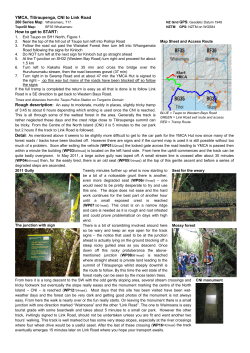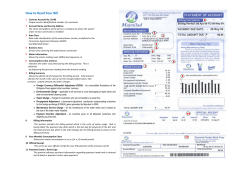
How To Combined TPS and GPS adjustment Version 4.2
How To Combined TPS and GPS adjustment Version 4.2 © Grontmij Nederland B.V. All rights reserved How To : Combined TPS and GPS adjustment Contents 1. Introduction 3 2. New MOVE3 Project 3 3. Options 4 4. Default standard deviations 6 5. Import GNSS/GPS baselines 7 6. Inner constraint network adjustment 9 7. Import TPS measurements 13 8. Adding known points 13 9. Adjustment in Phases 14 2 How To : Combined TPS and GPS adjustment 1. Introduction This document describes how measurement data from both TPS and GPS data collectors can be imported into MOVE3 and how the data can be adjusted as a combined network. TPS measurements from Leica GSI/DBX (Leica 1200), Topcon, Sokkia SDR33 and Trimble DC/JobXML format can be added to a MOVE3 project. GPS baselines can be imported from Leica ASC (from LGO) and DBX format (RTK measurements), Trimble DC and JobXML, Topcon tvf and Sokkia SGL. Please note that this is a sample. The actual settings may differ depending on your local requirements. 2. New MOVE3 Project Create a new MOVE3 project by specifying the project name. A template project (option file) can be selected to use previously defined project settings. 3 How To : Combined TPS and GPS adjustment 3. Options Starting a new project without using a template will set all options to the MOVE3 defaults. In this case you must set at least some of the options to meet the combined adjustment requirements. Set the Project options to both terrestrial and GPS. Select the proper Geoid model if available. Without geoid model, corrections from orthometric to ellipsoidal heights will not be applied. This may not be a problem if your working area is small ( < 5 km) . The EGM 2008 provides worldwide geoid data, but since it is a global model it does not have the highest accuracy (the EGM2008 geoid model must be downloaded and installed seprerately). Project tab sheet. 4 How To : Combined TPS and GPS adjustment In the Geometry tab the Dimension must be set to 3D or 2D, depending on the results you want to achieve. Please note that points measured with GPS will always be processed in 3D even if the Dimension switch is set to 2D. Select the proper projection and set the required projection parameters and ellipsoid. Geometry tab sheet. 5 How To : Combined TPS and GPS adjustment If GNSS/GPS parameters between WGS84 and the local system are available, they can be entered in the GPS transformation parameter tab. GNSS/GPS transformation parameters tab sheet. Set parameters to fixed and enter the appropriate values. Please check whether the parameters are available From Local to WGS84 or From WGS to Local. 4. Default standard deviations Before importing the data it is important to properly set the defaults for the standard deviations of the TPS observations direction, distance and zenith angle. The standard deviations have an absolute part and a relative. The default values are added to each imported observation. For GPS observations the covariance matrix will also be imported. 6 How To : Combined TPS and GPS adjustment Standard Deviations. 5. Import GNSS/GPS baselines Select the menu option Import/export | GNSS/GPS baselines and specify the manufacturer. Then click Import and select the GNSS/GSP data file(s). 7 How To : Combined TPS and GPS adjustment Import GNSS/GPS file dialog. The imported data will be shown in the observation list that can be opened under View | Observations. Observation dialog The import also adds approximate GPS coordinates for all points and will give a proper display of the network. 8 How To : Combined TPS and GPS adjustment 6. Inner constraint network adjustment This network can be adjusted as a free network if you select to use the inner constraint adjustment in the Adjustment tab 9 How To : Combined TPS and GPS adjustment General options Geometry tab Then go to Compute| MOVE3 and adjust the free network to find errors in the observations. Compute Free network The MOVE3 report will give the testing results of the adjustment, allowing to identify errors when sufficient redundancy is available. 10 How To : Combined TPS and GPS adjustment MOVE3 adjustment report In the report the Test Summary helps identifying errors. The observation with the largest test-factor is the most likely error. To access the observation tab open the rejected items view from the Results menu. This view shows the observations listed in the test summary. 11 How To : Combined TPS and GPS adjustment Rejected observations Click the first item in the list to open the observation tab of the largest rejected observation. In this case we will deselect the rejected baseline. And re-compute the free network to check if other rejections are present. Edit observation tab sheet Once the free network is accepted additional total station measurements will be added. 12 How To : Combined TPS and GPS adjustment 7. Import TPS measurements Select the menu option Import/export | Total Station and specify the manufacturer. Then click Import and select the raw data file(s). Import Total Station dialog. 8. Adding known points A proper adjustment requires that all control points are added as known stations. Go to the View | Station and edit the control stations. Enter the proper station coordinates and check the Known check boxes. Adding Known Points Alternatively known points can also be added via the Import/export menu option Coordinate file. 13 How To : Combined TPS and GPS adjustment Import Known Points 9. Adjustment in Phases You’re now ready to adjust the combined network. It is best to do a free network first for the combined network to perform testing on the observations and find outliers. Go to Compute| MOVE3 and set the phase to Free network. Compute Free network The MOVE3 report will give the testing results of the adjustment, allowing to identify errors when sufficient redundancy is available. 14 How To : Combined TPS and GPS adjustment In case one does not meet the predefined quality of the observations the global F-test will be rejected. This may be caused by either a too optimistic set of standard deviations of the observations or by observation errors. Usually a rejection is caused by errors in the observations. To identify the observation errors one can use the W-test. The observation with the largest W-test is the most suspect observation. One should try to solve the cause of the error, maybe there was a problem during import of the raw observations that can be corrected. The estimated error can be used for this purpose because it gives an estimate of the size of the observational error. If the error cannot be repaired, the observation can be deselected (not used in the adjustment). This will however affect the reliability of the network. In some cases rejected observations may have to be re-measured to maintain proper reliability. After an acceptable Free network adjustment the combined network can be constrained to all available control points in the Absolute constrained adjustment. This phase will result in testing of the available control heights and the final adjusted coordinate computation. Compute Absolute constrained network The quality of the control points (the standard deviation of the known coordinates) is taken into account for testing. If the combined network does not fit to the control points there may be rejected points. If the F-test is rejected, the largest W-test value can be used to identify the errors. If a control point is rejected this may have been caused by a mistake in entering the known points coordinates or by entering a wrong control point. It is best to check this out first. There may be a deformation in the control points as well, causing the error. If the problem cannot be solved the control point can be removed as a control point for the adjustment. The point will then be readjusted, getting new adjusted coordinates. The final results are stored in the MOVE3 report file, but they are also written to the MOVE3 COR file. The adjusted coordinates can also be exported using the Import/export menu option Adjusted Coordinates. Specify the format and the fields you want to export and write the data to an ASCII file. 15 How To : Combined TPS and GPS adjustment Export Adjusted Coordinates tab sheet 16
© Copyright 2025











